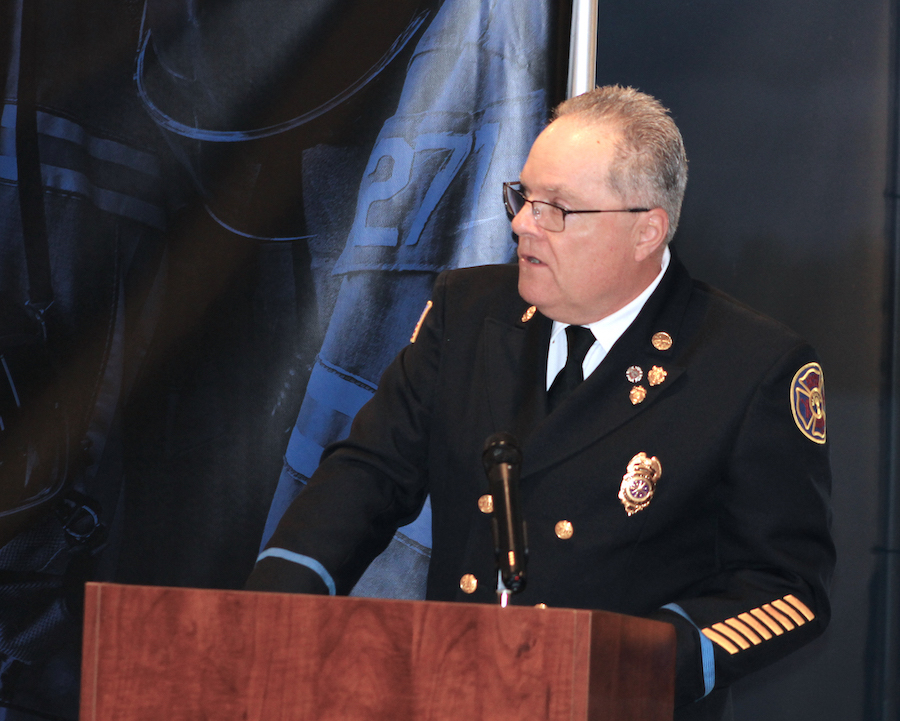Featured News - Current News - Archived News - News Categories
Buffalo & Watertown metro areas could see 2-3 feet of lake-effect snow accumulation through Thursday
√ Heaviest snowfall will be Wednesday, with snowfall rates of 2-4 inches per hour
√ New Yorkers can subscribe for emergency alerts here
Submitted by the Office of Gov. Kathy Hochul
Gov. Kathy Hochul today urged New Yorkers to prepare for another lake-effect snow event that is forecast to bring 1 to 3 feet of snow to areas in Western and Northern New York, especially near Lake Erie and Lake Ontario, starting Tuesday afternoon and continuing through Thursday night.
In Western New York, the most snow is expected to fall in the Buffalo metro area and will be heaviest on Wednesday with rates up to 2-3 inches per hour. In Northern New York, the most snow is forecast for the Watertown area, Tug Hill and northern Oswego County, and will also be heaviest on Wednesday with snowfall rates up to 2-4 inches per hour at times.
Winds are expected to gust up to 35-40 mph, especially Wednesday, which will create blowing and drifting snow in both Western and Northern New York areas. Wind chills are forecast to dip down to the negatives or low single digits for several days, continuing through Sunday.
The combination of wind, snow and freezing temperatures will likely make travel dangerous, so drivers should avoid unnecessary travel – especially on Wednesday. The lake-effect snow event may also cause power outages in some locations.
“While this next wave of weather isn’t expected to be as impactful as last weekend’s storm, New Yorkers should still be prepared,” Hochul said. “Our state agencies are continuing to work around the clock to monitor conditions, clear the roads (and) support localities. My top priority is to keep New Yorkers safe.”
New Yorkers can sign up for emergency alerts by subscribing to NY Alert at https://alert.ny.gov, a free service providing critical emergency information to your cell phone or computer. For a complete listing of weather alerts and forecasts, visit the National Weather Service website at https://alerts.weather.gov.
Agency Activities
•The New York State Division of Homeland Security and Emergency Services has activated the state’s emergency operations center in Albany to coordinate the state's response throughout the severe weather event. The office of emergency management is in contact with local counterparts and is prepared to facilitate requests for assistance, and state stockpiles are staffed and ready to deploy emergency response assets and shelter supplies as needed.
•The New York State Department of Transportation is monitoring weather conditions and prepared to respond with more than 3,720 supervisors and operators. All field staff are available to fully engage and respond. All residencies in impacted locations will remain staffed for 24/7 operations with operators, supervisors and mechanics throughout the duration of the event and priority cleanup operations.
To support response and ongoing cleanup operations, the department is deploying an additional 16 operators, 2 supervisors, two snowblowers, and four skidsteers with snowblower attachments and trailers to Western New York. This is in addition to the personnel and equipment previously deployed to the region for the storm, which included 74 staff, including 54 additional operators, 11 supervisors, six equipment trainers, two incident command support specialists and one safety representative; along with 25 large snowplows, three large snowblowers, two loaders and a grader.
Statewide equipment numbers are as follows:
For real-time travel information, motorists should call 511 or visit https://www.511ny.org or the mobile site at m.511ny.org, New York state's official traffic and travel information source.
•The Thruway Authority is ready to respond to the lake-effect winter storm in Western New York with 700 operators and supervisors available statewide. The agency is shifting additional staff and snow fighting equipment from the Syracuse, Albany and New York divisions to support snow and ice operations in Western New York.
Staff is currently monitoring the storm track and additional operators and equipment are on standby and will be deployed if conditions warrant.
Statewide equipment numbers and resources are listed below:
Variable message signs and social media are utilized to alert motorists of winter weather conditions on the thruway.
The Thruway Authority encourages motorists to download its mobile app, which is available for free on iPhone and Android devices. The app provides motorists direct access to real-time traffic information, live traffic cameras, and navigation assistance while on the go. Motorists can also sign up for TRANSalert emails and follow @ThruwayTraffic on X for the latest traffic conditions along the thruway.
•Department of Public Service: Utility companies regulated by the Department of Public Service have approximately 5,500 workers available statewide to engage in repair and restoration efforts for the winter weather system this weekend. DPS staff will track utilities' work throughout the event and ensure utility companies shift appropriate staffing to regions that experience the greatest impact. If your service is interrupted, visit the DPS utility service interruptions website for tips.
•The New York State Police continues to monitor weather conditions and is deploying additional troopers to impacted areas, as needed. All State Police four-wheel drive and specialized vehicles, including snowmobiles, airboats and utility-terrain vehicles, are staged, and necessary equipment is being utilized for immediate response, as needed. All emergency power and communications equipment are functioning appropriately.
•New York State Department of Environmental Conservation emergency management staff, environmental conservation police officers, forest rangers and regional staff remain on alert and continue to monitor the developing situation and weather forecasts. DEC is coordinating resource deployment with agency partners and all available assets to targeted areas in preparation for potential impacts due to heavy snow.
DEC reminds those responsible for the removal and disposal of snow to follow best management practices to help prevent flooding and reduce the potential for pollutants like salt, sand, oils, trash and other debris in snow from affecting water quality. Disposal of snow in local creeks and streams can create ice dams, which may cause flooding in nearby areas. Public and private snow removal operators should be aware of these safety issues during and after winter storms. Additional information is available at https://extapps.dec.ny.gov/docs/water_pdf/togs5111new.pdf.
•New York State Office of Parks, Recreation and Historic Preservation: Park Police and park personnel are on alert and closely monitoring weather conditions and impacts. Response equipment is being fueled, tested and prepared for storm response use. State Parks has sawyer crews in Western New York and the North Country on standby for deployment for potential road clearing operations.
Safety Tips – Winter Weather
√ Service snow removal equipment. Use rock salt to melt ice on walkways, and sand to generate traction.
√ Winterize your home and have heating sources inspected annually.
√ If you use heating oil, maintain an adequate supply.
√ Have safe, emergency heating equipment available and use according to manufacturer’s instructions.
√ Install and check smoke alarms.
√ Protect water pipes from freezing.
Traveling in Winter Weather
Some of the most important tips for safe driving include:
√ Do not drive unless necessary.
√ If you must travel, make sure your car is stocked with survival gear like blankets, a shovel, flashlight and extra batteries, extra warm clothing, set of tire chains, battery booster cables, quick energy foods and brightly colored cloth to use as a distress flag.
√ If you have a cell phone or other communications device such as a two-way radio available for your use, keep the battery charged and keep it with you whenever traveling. If you should become stranded, you will be able to call for help, advising rescuers of your location.
√ The leading cause of death and injuries during winter storms is transportation accidents. Before getting behind the wheel, make sure that your vehicle is clear of ice and snow. Good vision is key to good driving. Plan your stops and keep more distance between cars. Be extra alert and remember that snowdrifts can hide smaller children. Always match your speed to the road and weather conditions.
√ It is important for motorists on all roads to note that snowplows travel at speeds up to 35 mph – which in many cases is lower than the posted speed limit – to ensure that salt being dispersed stays in the driving lanes and does not scatter off the roadways. Oftentimes on interstate highways, snowplows will operate side by side, as this is the most efficient and safe way to clear several lanes at one time.
√ Motorists and pedestrians should also keep in mind that snowplow drivers have limited lines of sight, and the size and weight of snowplows can make it very difficult to maneuver and stop quickly. Snow blowing from behind the plow can severely reduce visibility or cause whiteout conditions. Motorists should not attempt to pass snowplows or follow too closely. The safest place for motorists to drive is well behind the snowplows where the roadway is clear and salted. Never attempt to pass a snowplow while its operating.
Power Outages – Planning
√ If you use medication that requires refrigeration, most can be kept in a closed refrigerator for several hours without a problem – check with your physician or pharmacist.
√ If you have space in your refrigerator or freezer, consider filling plastic containers with water, leaving an inch of space inside each one. This will help keep food cold if the power goes out.
√ Plan to have an alternative cooking source, such as a camp stove or outdoor grill. Follow appropriate safety rules for its use outside the residence.
√ Consider buying a generator and follow the rules for using it outside the residence. Before installing a generator, be sure to properly disconnect from your utility electrical service. If possible, have your generator installed by a qualified electrician.
√ Have extra blankets, coats, hats and gloves on hand to keep warm.
√ If you have a computer, back up files and operating systems regularly. Turn off all computers, monitors and other devices when they are not being used.
√ If you have an electric garage door opener, locate the manual release level, and learn how to operate.
√ If you have a telephone instrument or system that requires electricity to work, plan for alternate communication such as a standard telephone handset, cellular telephone, or radio.
What to Do If the Power Goes Out
√ Turn off or disconnect major appliances and other equipment (e.g., computers), in case of a momentary power surge that can damage these devices. Keep one light turned on so you know when power returns. Consider using surge protectors wherever you use electronic equipment.
√ Call your utility provider to notify it of the outage, and listen to local broadcasts for official information. Check with your utility to determine area repair schedules.
√ Check to see if neighbors and those with access or functional needs have power.
√ Use only flashlights for emergency lighting – candles pose the risk of fire.
√ Keep refrigerators and freezer doors closed – most food requiring refrigeration can be kept safely in a closed refrigerator for several hours. An unopened refrigerator will keep food cold for approximately four hours. A full freezer will keep the temperature for about 48 hours.
√ Do not use a charcoal grill indoors and do not use a gas stove for heat – they could give off harmful levels of carbon monoxide.
√ Stay warm by dressing in layers and minimizing time spent outdoors. Be aware of cold stress symptoms (i.e., hypothermia), and seek proper medical attention if symptoms appear.
√ Close off rooms you do not need.
•To report an electric outage, call:
Heating Safety
√ Use only safe sources of alternative heat such as a fireplace; small, well-vented wood or coal stove; or portable space heaters.
√ When using alternative heat sources such as a fireplace, woodstove, etc., always make sure you have proper ventilation. Always follow manufacturer's instructions.
√ Keep curtains, towels and potholders away from hot surfaces.
√ Have a fire extinguisher and smoke detectors and make sure they work.
√ If you use kerosene heaters to supplement your regular heating fuel, or as an emergency source of heat, follow these safety tips: Follow the manufacturers' instructions. Use only the correct fuel for your unit. Refuel outdoors only, and only when the unit is cool. Keep the heater at least 3 feet away from furniture and other flammable objects. When using the heater, use fire safeguards and ventilate properly.
For more winter safety tips, visit https://dhses.ny.gov/safety. For all non-emergency service needs in New York state before, during or after a storm, call 211 or visit 211nys.org.
The Division of Homeland Security and Emergency Services (DHSES) provides leadership, coordination and support to prevent, protect against, prepare for, respond to, recover from, and mitigate disasters and other emergencies. For more information, follow @NYSDHSES on Facebook, Instagram, and X (formerly known as Twitter), or visit dhses.ny.gov.





























